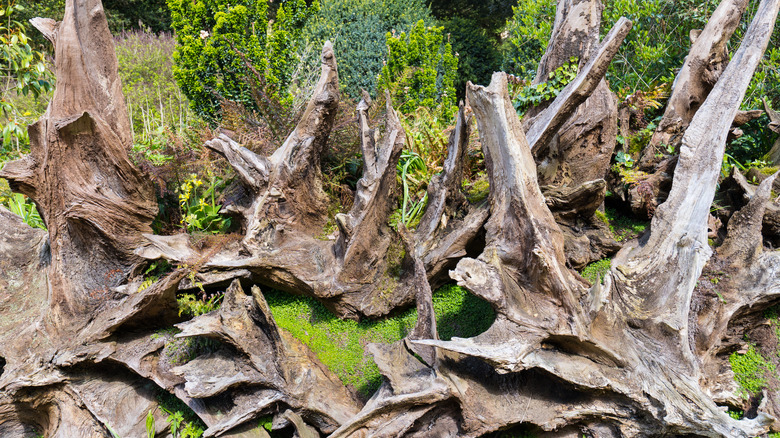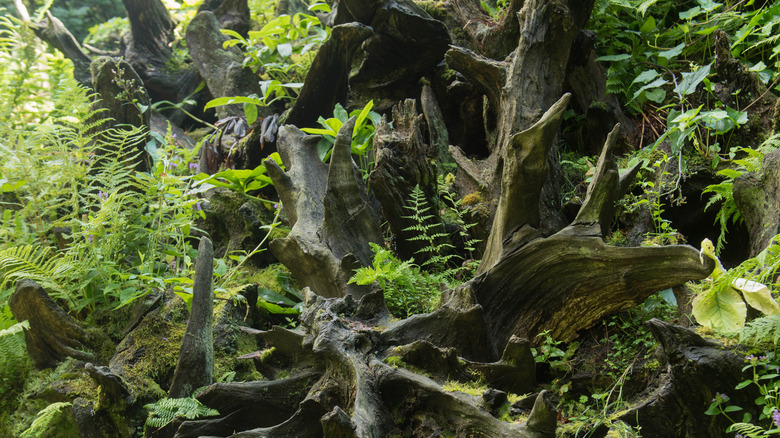Just like with fashion, garden trends come and go, and this 2024, stumperies are making a triumphant return to the horticulture scene. Originating during the Victorian times, stumperies are making a resurgence, captivating garden enthusiasts with their unique charm and environmental benefits. A stumpery is not just a collection of old tree stumps; it’s a carefully designed garden feature that celebrates life emerging from decay and creates a haven for biodiversity.
The concept of stumperies dates back to the 19th century when they were popularized by Victorian gardeners as a way to showcase the remnants of felled trees or stumps. Fast forward to today, and stumperies are experiencing a renaissance. Gardeners are recognizing their potential for sustainable landscaping, providing a haven for wildlife, and adding a touch of enchantment to outdoor spaces.
What exactly is a stumpery? At its core, a stumpery is a carefully arranged assemblage of tree stumps, logs, and other decaying wood. It’s not just an aesthetic choice; it’s an intentional recognition of nature’s cycles. Now, let’s delve into the key components that define a stumpery and explore how you can create your own.
Creating your own stumpery

To embark on your own stumpery journey, make sure you clear the site or area you’ve chosen for your stumpery first. Gather materials like tree stumps, logs, driftwood, and branches. Arrange them artistically while aiming for a naturalistic formation, creating a dynamic, multi-level structure. Don’t shy away from incorporating moss-covered or lichen-adorned pieces for added character. Select shade-tolerant plants that thrive in the microclimates created by decaying wood. Ferns, mosses, and hostas are excellent choices, bringing lush greenery to contrast with the rustic wood. Consider adding woodland bulbs like native bluebells, narcissi, daffodils, and snowdrops for seasonal pops of color.
The process of creating a stumpery is both creative and sustainable. Use fallen branches from your own garden or repurpose wood from tree removals, including tree roots. Stack and interweave the materials, leaving crevices for wildlife to inhabit. Over time, as the wood decomposes, it becomes a fertile ground for fungi, frogs, and insects, enriching the biodiversity of your garden.
Benefits of a stumpery

Beyond its enchanting appearance and ability to host a range of insects, animals, and plants, a stumpery offers a plethora of benefits. Firstly, it provides food for insects, fungi, and small mammals. Secondly, the decaying wood acts as a natural sponge, retaining moisture and creating a microclimate ideal for shade-loving plants.
A stumpery is also a low-maintenance garden feature as the emphasis is on the natural growth of various types of flora on decaying or deadwood. The process means less pruning and upkeep compared to the maintenance needed for traditional gardens. Furthermore, a stumpery is a versatile, eco-friendly choice. It can be large or small depending on how much space is available and utilizes recycled materials, thereby contributing to a sustainable gardening ethos.
If you’re still undecided about the design of your stumpery, you can check out the photos of some famous stumperies (or visit them in person) for inspiration. These include King Charles the III’s Highgrove House and Gardens, Ickworth House, and the Biddulph Grange Garden, all in the United Kingdom, plus the world’s biggest stumpery at the Rhododendron Species Botanical Garden (RSBG) in Washington state that’s open to the public.As you enjoy the aesthetic appeal of your stumpery this 2024, take pride in the mini-ecosystem you’ve created. Embrace the Victorian spirit and let your stumpery celebrate nature’s resilience and perpetual cycle of life.



